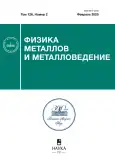Modelling mixed 1d/3d diffusion of radiation defects in elastic fields: case study on bcc metals Fe and V
- 作者: Demidov D.N.1, Sivak A.B.1
-
隶属关系:
- National Research Center “Kurchatov Institute”
- 期: 卷 126, 编号 2 (2025)
- 页面: 192-202
- 栏目: СТРУКТУРА, ФАЗОВЫЕ ПРЕВРАЩЕНИЯ И ДИФФУЗИЯ
- URL: https://journal-vniispk.ru/0015-3230/article/view/295089
- DOI: https://doi.org/10.31857/S0015323025020084
- EDN: https://elibrary.ru/AYWVVK
- ID: 295089
如何引用文章
详细
A method for modeling the diffusion of radiation defects (RD) with a mixed 1D/3D diffusion mechanism (the defect migrates one-dimensionally, occasionally changing the direction of its one-dimensional migration) in inhomogeneous elastic fields is proposed based on the object kinetic Monte Carlo method. Within this method, the influence of the elastic field on the frequencies of direction changes in RD migration and on the frequencies of their jumps along one-dimensional directions is taken into account using dipole tensors of the corresponding saddle configurations of RD within the framework of anisotropic linear elasticity theory. Such dipole tensors are defined based on the analysis of molecular dynamics data on RD diffusion in homogeneous elastic fields using the developed kinetic model. Using the proposed method, the dependencies dislocations sink strengths for di-interstitials as a function of temperature (in the range of 293–1000 K) and dislocation density (in the range of 1014–1015 m-2) in BCC metals Fe and V have been calculated. Straight full screw and edge dislocations in slip systems ⟨111⟩{110}, ⟨111⟩{112}, ⟨100⟩{100}, ⟨100⟩{110} are considered. Analytical expressions approximating the calculated dependencies of sink strengths of dislocations on temperature and dislocation density are proposed.
全文:
作者简介
D. Demidov
National Research Center “Kurchatov Institute”
编辑信件的主要联系方式.
Email: Demidov_DN@nrcki.ru
俄罗斯联邦, Moscow
A. Sivak
National Research Center “Kurchatov Institute”
Email: Demidov_DN@nrcki.ru
俄罗斯联邦, Moscow
参考
- Elastic strain fields and dislocation mobility / Eds V.L. Indenbom, J. Lothe. North-Holland. Amsterdam: Elsevier Science, 1992. 793 p.
- Hirth J.P., Lothe J. Theory of Dislocations. New York: Wiley, 1982. 857 p.
- Heinisch H.L., Singh B.N., Golubov S.I. A kinetic Monte Carlo study of mixed 1D/3D defect migration // J. Comput. Aided Mater. Des. 1999. V. 6. P. 277–282.
- Barashev A.V., Golubov S.I., Trinkaus H. Reaction kinetics of glissile interstitial clusters in a crystal containing voids and dislocations // Philos. Mag. A. 2001. V. 81. P. 2515–2532.
- Trinkaus H., Heinisch H.L., Barashev A.V., Golubov S.I., Singh B.N. 1D to 3D diffusion-reaction kinetics of defects in crystals // Phys. Rev. B. 2002. V. 66. P. 06010.
- Malerba L., Becquart C.S., Domain C. Object kinetic Monte Carlo study of sink strengths // J. Nucl. Mater. 2007. V. 360. P. 159–169.
- Stoller R.E., Zarkadoula E. 1.20. Primary Radiation Damage Formation in Solids. Comprehensive Nuclear Materials (Second Edition). Elsevier. 2020. P. 620–662.
- Bortz A.B., Kalos M.H., Lebowitz J.L. A new algorithm for Monte Carlo simulation of Ising spin systems // J. Comput. Phys. 1975. V. 17. № 1. P. 10–18.
- Kröner E. Allgemeine Kontinuumstheorie der Versetzungen und Eigenspannungen // Arch. Rational Mech. An. 1959/60. V. 4. P. 273–334.
- Puls M.P., Woo C.H. Diaelastic polarizabilities due to vacancies and interstitials in metal // J. Nucl. Mater. 1986. V. 139. № 1. P. 48–59.
- Osetsky Y.N., Bacon D.J., Serra A., Singh B.N., Golubov S.I. One-dimensional atomic transport by clusters of self-interstitial atoms in iron and copper // Philos. Mag. 2003. V. 83. № 1. P. 61–91.
- Романов В.А., Сивак А.Б., Чернов В.М. Кристаллографические, энергетические и кинетические свойства собственных точечных дефектов и их кластеров в ОЦК-железе. 6. Кластеры собственных межузельных атомов // ВАНТ. Сер. Материаловедение и новые материалы. 2006. T. 66. № 1. C. 223–232.
- Демидов Д.Н., Сивак А.Б., Сивак П.А. Диффузия димежузлий в ОЦК-металлах Fe и V, подверженных внешним нагрузкам разных типов // ФММ. 2021. T. 122. № 11. C. 1164–1170.
- Demidov D.N., Sivak A.B., Sivak P.A. New method for calculation of radiation defect dipole tensor and its application to di-interstitials in copper // Symmetry. 2021. V. 13. No. 7. P. 1154.
- Новик А., Берри Б. Релаксационные явления в кристаллах / А. Новик, Б. Берри; пер. с англ.: под ред. Э.М. Надгорного, Я.М. Сойфера. М.: Атомиздат, 1975. 472 с.
- Sivak A.B., Demidov D.N., Sivak P.A. Diffusion characteristics of radiation defects in iron: molecular dynamics data // ВАНТ. Сер. Термоядерный синтез. 2021. T. 44. № 2. C. 148–157.
- Demidov D.N., Sivak A.B., Sivak P.A. Диффузионные характеристики кластеров собственных междоузельных атомов в ванадии: молекулярно-динамические данные // ФММ. 2023. T. 124. № 5. С. 400–408.
- Dederichs P.H., Schroeder K. Anisotropic diffusion in stress fields // Phys. Rev. B. 1978. V. 17. P. 2524‒2436.
- Sivak A.B., Sivak P.A., Romanov V.A., Chernov V.M. Dislocation sinks efficiencies for self-point defects in iron and vanadium crystals // Inorg. Mater.: Appl. Res. 2015. V. 6. No. 2. P. 105–113.
- Демидов Д.Н., Сивак А.Б., Сивак П.А. Кристаллографические, энергетические и диффузионные характеристики димежузлий в ОЦК-металлах Fe и V // ВАНТ. Сер. Термоядерный синтез. 2019. Т. 42. № 3. С. 85–96.
- Романов В.А., Сивак А.Б., Чернов В.М. Кристаллографические, энергетические и кинетические свойства собственных точечных дефектов и их кластеров в ОЦК-железе. 1. Полуэмпирическая модель ОЦК-железа и потенциал межатомного взаимодействия // ВАНТ. Сер. Материаловедение и новые материалы. 2006. Т. 66. № 1. С. 129–150.
- Романов В.А., Сивак А.Б., Сивак П.А., Чернов В.М. Равновесные и диффузионные характеристики собственных точечных дефектов в ванадии // ВАНТ. Сер. Термоядерный синтез. 2012. Т. 35. № 2. С. 60–80.
- Сивак А.Б., Демидов Д.Н., Сивак П.А. Эффективности дислокационных стоков для димежузлий в ОЦК (Fe, V) и ГЦК (Cu) металлах // ВАНТ. Сер. Материаловедение и новые материалы. 2021. Т. 109. № 3. С. 30–53.
- Wiedersich W. On the theory of void formation during irradiation // Radiat. Eff. 1972. V. 12. P. 111–125.
- Nichols F.A. On the estimation of sink-absorption terms in reaction-rate-theory analysis of radiation damage // J. Nucl. Mater. 1978. V. 75. P. 32–41.
- Trinkaus H., Heinisch H.L., Barashev A.V., Golubov S.I., Singh B.N. 1D to 3D diffusion-reaction kinetics of defects in crystals // Phys. Rev. B. 2002. V. 66. No. 6. 060105(R).
补充文件














